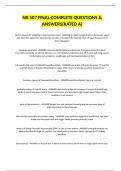NR 507 FINAL COMPLETE QUESTIONS &
ANSWERS(RATED A)
body's process for adapting to high hormone level - ANSWER To adapt to high levels of hormones, some
cells have the capacity to decrease the number of receptors for that hormone through the process of
down-regulation.
Cushing's Syndrome - ANSWER excessive ACTH (Adrenocorticotropic hormone) production most
commonly caused by an adrenal adenoma or a non-pituitary adenoma as is often seen with lung cancer.
Clinical signs and symptoms: weight gain and hyperpigmentation of skin.
Lab results that point to PRIMARY hypothyroidism - ANSWER Low levels of thyroid hormone (T3 and T4)
and high levels of thyroid-stimulating hormone (TSH), most commonly caused by autoimmune
thyroiditis.
Common causes of hypoparathyroidism - ANSWER parathyroid gland injury or removal
pathophysiology of thyroid storm - ANSWER High levels of thyroid hormone in conjunction with high
levels of stress hormones lead to fever, tachycardia, and eventually high-output heart failure if the
condition is not treated.
signs of thyrotoxicosis - ANSWER Weight loss and enlarged thyroid gland are common signs of
hyperthyroidism in thyrotoxicosis.
diet and the prevention of prostate cancer - ANSWER some evidence suggests a low fat diet, low dairy
intake and increased fruit and veggie intake prevents prostate cancer
Impact of Benign Prostatic Hypertrophy (BPH) on the urinary system - ANSWER enlarged prostate can
block urine flow through the urethra. Can cause urinary retention, which can lead to UTI, kidney
infections.
Dermatomes - ANSWER an area of skin in which sensory nerves derive from a single spinal nerve root.
,Each spinal nerve and their many processes are distributed to a specific area of the body. Specific areas
of cutaneous (skin) innervation at these spinal cord segments are called dermatomes. The dermatomes
of various spinal nerves are distributed in a fairly regular pattern, although adjacent regions between
dermatomes can be innervated by more than one spinal nerve.
substance release at the synapse - ANSWER neurons form points of contact with other neurons through
synapse. Impulses transmitted through electric and chemical conduction. Vesicles containing
neurotransmitters release their contents into the synaptic cleft and neurotransmitters diffuse across the
cleft and bind to specific receptors on postsynaptic neuron and trigger an action potential.
Common neurotransmitters include norepinephrine, acetylcholine, dopamine, histamine, serotonin,
glycine, endorphins.
Spondylolysis - ANSWER Structural defect (degeneration, fracture, or developmental defect) in the pars
interarticularis of the vertebral arch (the joining of the vertebral body to the posterior structures). Most
affected at L5 of lumbar spine. Mechanical pressure often causes anterior displacement of the deficient
vertebra (spondylolisthesis). Often hereditary; associated with increased incidence of other congenital
spine defects. Microfractures occur at site, symptoms include lower back pain and lower limb pain.
Cervical spondylolysis is hypertrophy and disc degeneration with narrowing of cervical spine at c5-c6 and
c6-c7. Signs/symptoms include neck or occipital pain, pain in shoulder, scapula, or arms. Sensory
symptoms of numbness or tingling follow a dermatomal pattern; weakness follows the pattern of
innervation of the affected nerve root. Occipital or suboccipital headache is another symptom. Can also
cause difficulty walking, altered sensation in feet, and sphincter disturbances (late sign).
location of the motor and sensory areas of the brain - ANSWER frontal lobe-goal oriented behavior, short
term memory, elaboration of thought, and inhibition on the limbic (emotional) areas of CNS
premotor area-programming motor movements
primary motor area in frontal lobe- forms primary voluntary motor area- electrical stimulation of specific
areas of this cortex causes specific muscles to move. Contains corticobulbar tract that synapses in
brainstems and provides voluntary control of neck and head muscles. Corticospinal tracts descend into
spinal cord and control muscles in the body. Cerebral impulses control function on opposite sides of
body-contralateral control.
Broca area- inferior frontal lobe; is for speech and language processing. Expressive aphasia or dysphasia
occurs when area is damaged.
Parietal lobe- major area for somatic sensory input, located along the postcentral gyrus, which is
adjacent to the primary motor area in the precentral gyrus. Communication between the two areas is
through association fibers. Involved in sensory association.
, Occipital lobe- behind parietal lobe and above cerebellum. Primary visual cortex, receives input from
retinas
Temporal lobe- primary auditory cortex, also in memory consolidation and smell. Wenicke area-sensory
speech area; responsible for reception and interpretation of speech, can result in receptive aphasia or
dysphasia when damaged.
conditions that result in pure water deficit (hypertonic volume depletion) - ANSWER a result of pure
water losses, hyperventilation, arid climates and an increase in renal clearance
osmoreceptors that stimulate thirst and the release of ADH - ANSWER Increased osmolality stimulates
hypothalamic osmoreceptors causing thirst and signals the posterior pituitary to release ADH
causes of hypernatremia - ANSWER Caused by an acute increase sodium level or loss of water
Hypovolemic hypernatremia: loss of body sodium accompanied by a relatively greater loss of body water
Causes: loop diuretics, osmotic diuresis, GI losses and kidneys failing to concentrate urine
Hypervolemic hypernatremia: increase in total body water and greater increase in total body sodium
Causes: hypertonic saline solutions, over secretion of ACTH, near salt water drowning
Euvolemic: (most common) loss of free water with near normal total body sodium
Causes: inadequate water intake, excessive sweating, fever with hyperventilation and water loss from
lungs, burns, nausea/vomiting and Diabetes Insipidus
effects of increased aldosterone - ANSWER Myocardial changes associated with heart failure, increased
sodium and water reabsorption by nephron collecting duct
dependent edema - ANSWER Fluid accumulates in gravity-dependent areas. May appear in feet and legs
when standing and when pressing with fingers a pit will remain after you remove your fingers.
definition of isotonic - ANSWER Solution or fluid having same osmotic pressure as the other solution or
fluid
principle of capillary oncotic pressure - ANSWER Form of osmotic pressure.
Chemical force exerted by large molecules (ex. proteins/albumins) to pull fluid in




